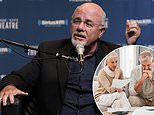ME AND MY OPERATION: This prostate test during your op can spare a man's love life

Bob Richmond, 47, had prostate cancer
More than 6,000 men a year undergo surgery for prostate cancer. A new technique can help reduce the risk of nerve damage and impotence. Bob Richmond, 47, a commercial manager who lives with his wife and two children in Hertfordshire, had the operation in June last year, as he tells SOPHIE GOODCHILD...
THE PATIENT
One morning in February last year, I woke with a mild burning sensation in my bladder. I thought it might be a urinary tract infection.
But when I saw my GP he gave me a rectal examination and said my prostate gland felt slightly enlarged. He also did a PSA blood test, which checks for levels of prostate specific antigen (PSA).
A normal level for a man my age is around three - my result was much higher, which my GP said could indicate cancer.
So that March I was referred to Jim Adshead, a surgeon at Spire Harpenden Hospital, using my private health insurance. After another rectal examination, he found a lump in my prostate and arranged an MRI scan. This revealed an abnormally dense area in my prostate gland, very close to the outer edge of the prostate.
Apparently, this clearly indicated cancer, which was confirmed by a biopsy. My cancer was then given a Gleason score of six, suggesting it was slow growing.
But Mr Adshead suspected it might be faster growing than that, given the size of the abnormal area on the scan. He explained that he might need to remove my prostate altogether - a prostatectomy - to stop the cancer spreading.
He outlined alternatives, including high-energy radiation to destroy cancer cells. But there are potential long-term effects, such as damage to the healthy tissue. And as I'm still young, common sense told me removing the entire gland was better.
I knew a prostatectomy can affect your sex life - the prostate sits close to the nerves which control erectile function and these can be damaged. But I was told the surgeon would peel these nerves back before cutting out the prostate, so they're protected during the procedure.
One problem with nerve-sparing surgery is that cancer cells may be left behind. But Mr Adshead said he was using a new technique that checks this: if there's not enough of a margin of healthy tissue to spare the nerves, they can then be removed if necessary.

The commercial manager, who lives with his family in Hertfordshire, had the new operation in June last year
Last June, I had the three-hour operation. I went home after two days. I had to wear a catheter for ten days, and needed mild pain relief for a week. I started working from home at the start of July, and returned to the office a month later.
I was advised not to do vigorous exercise for three to four weeks so that my wounds (five 8mm puncture holes on my stomach) would heal quickly.
But my treatment has been completely effective - my PSA score is now nearly zero.
My sex life has not been affected, nor am I incontinent (another risk of prostate surgery). I'll have check-ups every six months, but my wife and I are now focused on enjoying life to the full. We've been to Barbados twice since the operation and I haven't looked back.
THE SURGEON
Jim Adshead, a consultant urological surgeon at the Lister Hospital, Stevenage, and Spire Harpenden Hospital.
Every year, 6,500 men - typically aged 45 to 70 - have their prostate surgically removed after being diagnosed with cancer.
All surgery carries risks, and up to 5 per cent of prostatectomy patients are left incontinent if the muscle which holds urine in the bladder is damaged.
The operation can also affect a man's sex life by stopping him getting an erection. The prostate is enclosed within a capsule and is covered on either side by a bundle of microscopic nerves, which enable a man to achieve an erection.
But these nerves are easily damaged. Twenty years ago, we didn't know where these nerves were and it was common for surgeons to cut through them, or remove them along with the gland, leaving men without sexual function.

Every year, 6,500 men have their prostate surgically removed after being diagnosed with cancer
Now, we can offer nerve-sparing surgery, where we peel back the thin layer of tissue containing the nerves from the gland's surface, remove the prostate and leave the nerve-rich tissue intact in the body. The most successful results are with robotic surgery - thanks to this, the rate of men suffering from erectile dysfunction after prostate surgery has fallen from 40 per cent to 20 per cent.
But nerve-sparing has a downside. The nerves create tiny puncture holes on the surface of the prostate to anchor themselves. Cancer cells can escape from the prostate through these holes and end up in the nerve tissue - this means they are left in the body, where they can keep growing.
Another issue is that prostate cancer is often detected late, so our patients often have advanced stage cancer that means cells are more likely to have escaped into the nerve tissue.
When a tumour is removed, the surgeon wants a layer - called a margin - of healthy tissues around the tumour to ensure the cancer is all out. To check if cancer cells remain, we do a biopsy on the prostate once it's removed. If there is no healthy margin, the patient may need to return for radiation treatment to target the remaining cancer cells in the nerve tissue.
Since 2013, I have been using a new cancer testing technique called NeuroSAFE.
Developed in Germany, it is effectively a way of taking a biopsy and getting the results while the patient is still asleep on the operating table, so we know whether it is safe to spare the nerve tissue. We get the results within half an hour - previously, it took between three days and two weeks.
Another advantage is that we can tell if one or both nerve bundles need taking out. If we only need to remove one, the patient still has an excellent chance of keeping erectile function.
The prostate is removed with the help of a robot. Under the control of the surgeon, it makes five 1cm incisions into the patient's abdomen, and inserts a camera into one of these.
We then peel away the nerve tissue and free the prostate. The gland is ring-shaped, and has the urethra - the tube that takes urine out of the body - running through it. To remove the prostate, we disconnect the urethra from the bladder. We then take out the prostate through a keyhole incision at the belly button.

Bob is now focused on enjoying life to the full
Next, we paint each side of the prostate - specifically the areas that were close to the important nerve bundles - with a different colour. This is to identify which area the tissue has come from and therefore which nerve bundle to remove if cancer cells are found.
The pathologist, who is in the operating theatre with me, freezes the gland and slices it, so that the outer, painted edge is clearly visible under a microscope.
With NeuroSAFE, the tissue samples are frozen in liquid nitrogen. This makes the samples rock hard so they can be sliced more thinly, making it easier for the pathologist to analyse under the microscope, giving us a speedy result. With the standard biopsy, we pour heated paraffin wax over the tissue samples and leave them to solidify, and it takes much longer to harden this way.
The time it takes to do the test now is just long enough for us to do other procedures, such as sewing the bladder back to the urethra, so the biopsy adds no time to the actual operation.
Fortunately, in Bob's case, the results showed that no cancer cells had been left.
We have performed robot-assisted prostatectomies using NeuroSAFE on 91 patients, with nine out of ten on the NHS. This has resulted in a major reduction in cancer cells being left behind (the risk has dropped from 15 per cent to 3 per cent) as well as a dramatic improvement in the preservation of sexual function.
Nerve-sparing is not advisable if the cancer is very advanced. But, of the 150 prostate removals I do a year, around half are suitable.
ANY DRAWBACKS?
'The advantage of NeuroSAFE is you get an immediate analysis so can go back and take any remaining cancer out,' says Ben Challacombe, a consultant urological surgeon at Guy's and St Thomas' NHS Foundation Trust.
'The downside is you'd need a pathologist to biopsy the prostate - and the NHS is not geared up for that. Also we need a larger long-term study to give us the data to see if this does improve outcomes.'
The cost for private patients is £14,890 to £15,640.
Most watched News videos
- Scottish woman has temper tantrum at Nashville airport
- Tesla Cybertruck explodes in front of Trump hotel in Las Vegas
- Mass panic as New Orleans attacker flies down Bourbon street
- Shocking moment zookeeper is fatally mauled by lions in private zoo
- Horrific video shows aftermath of New Orleans truck 'attack'
- Meghan Markle celebrates new year in first Instagram video
- Tesla Cybertruck burns outside Trump hotel in Las Vegas
- See how truck that drove into crowd made it through police barrier
- Cheerful Melania Trump bops to YMCA at Mar-a-Lago NYE bash
- New Orleans terror attack suspect reveals background in video
- Plane passenger throws drink at flight attendant in boozy fight
- Horrifying moment yacht crashes into rocks and sinks off Mexico coast










































































































































































































































































































































































